Sequence viewing > Index - Alternative Photo Emulsions - Resource - ©
Lloyd Godman
Alternative
Photographic Processes - (Hand
made photographic -emulsions and processes)
Brushes
for Alternative photographic processes
There
are a wide variety of brushes available and just as much variation in
the way the emulsion can be applied by each of them.
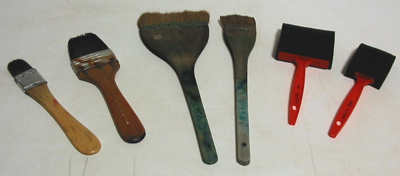
Suitable brushes for the application of the emulsion can differ between
processes, the surface to be coated and the aesthetic effect the photographer
is after.
There are three elements we can consider in the brush:
Stiffness of the bristles
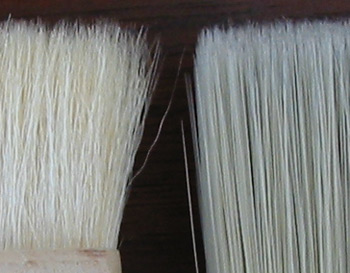
The hake brush on the left is softer than the house painting brush on the right - stiffer bristles are more likely to separate and leave brush marks than a softer brush which will create a more even coating.
|
Brush width
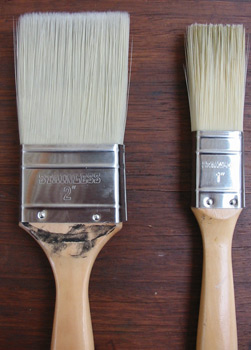
The wider the brush the more area we cover with each stroke. |
Brush thickness
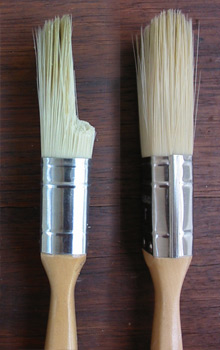
The thinner the brush the less emulsion that can be loaded and the quicker the emulsion runs out. As the emulsion runs dry the brush will leave recognizable brush strokes. If you want to exploit this effect you can cut away some of the thickness of the brush.
|
Metal
Ferrule brush:
The
metal ferrule on some brushes is made of steel or is fixed to
the handle by steel nails and rusts will begin to form with use.
If the emulsion reaches the metal the ferrule can rust can contaminate the chemical mixture. |
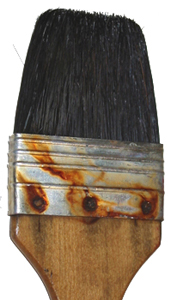 |
Medium soft bristles, the brush hairs can separate and create a reference to to brush application. |
More
expensive brushes have stainless steel ferrules which can sometimes
over come this problem. |
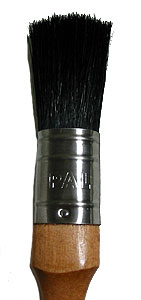 |
The bristles on this brush are coarser and will separate more than the previous brush, creating a greater reference to the brush application. |
| |
|
|
Goats
Hair or Hake brush with wooden handle and combined ferrule:
Some
goats hair brushes can be obtained where the fibres are bound
into the handle that becomes the ferrule with a linen or cotton
thread and unpainted wooden handles, however more recently the
thread used has been metal. This can be stripped out quite easily
and replaced with a linen thread. Some of these brushes came bound with bronze wire. This can easily be replaced with linen thread.
|
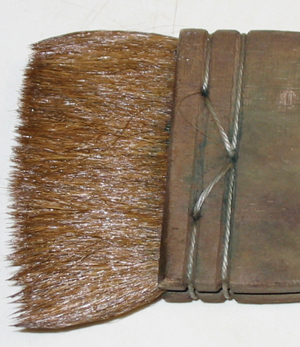 |
|
Synthetic
Sponge:
For
some applications where a smooth even coating is desirable, a brush made of synthetic sponge can be used
with great effect. As they are made with no metal there is no
threat of contamination to the chemical mixture. |
 |
|
Fine Brushes:
Finer
artist type paint brushes can be useful in applying the emulsion in
more intricate motifs and patterns, or to touch up small areas. There is great
variety in the quality of these and also the shape of the brush head.
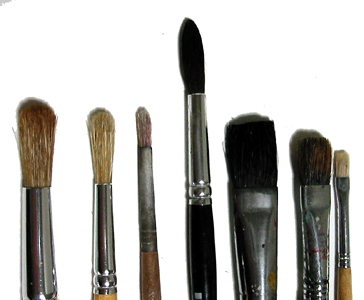
Rollers:
Roller
with the same synthetic sponge can be obtained which can be great
for creating a very smooth even coating of the emulsion. |
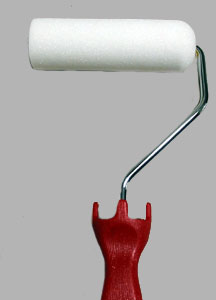 |
Feathers:
Feathers
can be very effective for some applications
|
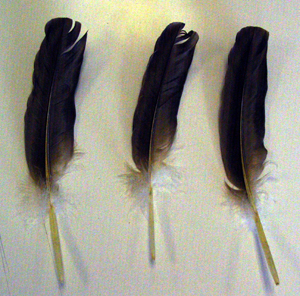 |
Cotton
Buds:
Cotton
buds and other materials can be use for very fine work, or to touch
up small areas.
Storage
and cleaning: Good brushes are expensive and it is wise to clean them
immediately after use and store them in a manner so the bristles don't
become damaged. To prevent any chance of contamination, some workers
mark their brushes and use them specific processes: ie . a set of brushes
for Cyanotype, and another set for Van
Dyke Brown.
*Leaving
the brushes to dry without washing can cause the brush to deteriorate
prematurely
*
Leaving the brushes soaking in water for extended periods will also
cause the brush to deteriorate prematurely. If the tip of the brush
is left resting on the bottom of a container the bristles can develop
a permanent upwards bend.
Want to learn more? - do a workshop or one on one with Lloyd Godman
|